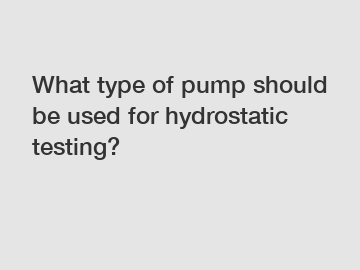What type of pump should be used for hydrostatic testing?
What type of pump should be used for hydrostatic testing?
Hydrostatic testing is a crucial process in various industries, such as plumbing, oil and gas, and construction. It involves filling a vessel or pipeline with a liquid and subjecting it to a specified pressure to check for leaks or structural integrity. To carry out this process efficiently, it is essential to use the right type of pump. In this article, we will explore the various types of pumps commonly used for hydrostatic testing and discuss their advantages and disadvantages.
1. Reciprocating Pumps:

Reciprocating pumps, also known as positive displacement pumps, are often used for hydrostatic testing due to their ability to provide high-pressure output. These pumps work by using a piston or plunger mechanism to create pressure by increasing the volume of the liquid being pumped. They can generate pressures up to 10,000 psi, making them suitable for demanding testing requirements. However, reciprocating pumps are generally slower and require more maintenance compared to other pump types.
2. Centrifugal Pumps:
Centrifugal pumps are widely used in various applications, but they are not the ideal choice for hydrostatic testing. These pumps work by using an impeller to create centrifugal force, which pushes the liquid forward. While centrifugal pumps are efficient for moving large volumes of liquid, they are not well-suited for generating the high pressure required for hydrostatic testing. They are generally limited to lower pressure applications and may not provide accurate results.
3. Air-Operated Pumps:
Air-operated pumps, also known as pneumatic pumps, are another popular option for hydrostatic testing. These pumps use compressed air to drive the liquid, providing a reliable and efficient solution. One advantage of air-operated pumps is that they can achieve high pressures while maintaining a steady flow rate. They are also safer to use in hazardous environments, as they eliminate the risk of electric sparks. However, air-operated pumps can be noisy, and they require a reliable source of compressed air to operate effectively.
4. Electric Pumps:
Electric pumps are widely used in various industries and can be a suitable choice for hydrostatic testing, depending on the specific requirements. These pumps are powered by electricity and can provide a consistent flow rate and pressure. They are relatively quiet and require minimal maintenance. However, electric pumps may not be capable of generating extremely high pressures, which can limit their use in certain applications.
Conclusion:
When it comes to choosing the right pump for hydrostatic testing, considering the specific requirements and constraints is crucial. Reciprocating pumps are ideal for high-pressure applications but may require more maintenance. Centrifugal pumps are not recommended for hydrostatic testing due to their limitations in generating high pressures. Air-operated pumps offer a reliable and safe solution, but they can be noisy and require a compressed air source. Electric pumps provide a consistent flow rate but may not be suitable for extremely high-pressure requirements. In conclusion, selecting the appropriate pump type for hydrostatic testing depends on factors such as desired pressure levels, flow rates, operational environment, and maintenance considerations.
For more information, please visit liquid injection pump, gas compressor machine, gas booster compressor working principle.

Comments
0